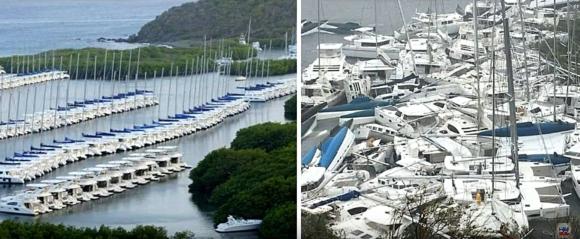
Paraquita Bay, Tortola — Before and After Hurricane Irma
When a hurricane approaches, there are only two choices for the crew of a yacht — either get out of the hurricane’s path, which may or may not be possible and can be very risky, or to hunker down in a “hurricane hole, an anchorage protected from the winds and seas until the hurricane passes. As long as a hurricane does not make a direct hit, “hurricane holes” usually provide refuge from the storms.
Among the best-known hurricane holes in the Caribbean is near Coral Bay, St. Johns, Virgin Islands, which is designated as the Hurricane Hole Storm Refuge in the Virgin Island’s Coral Reef National Monument. This year, however, not one, but two Cat 5 hurricanes struck the Caribbean hurricane holes dead on. First, Hurricane Irma struck in early September, with sustained winds of up to 185mph. Only two weeks later, Hurricane Maria followed with sustained winds of 175 mph. Tornadoes, spawned by the hurricanes, generated wind gusts of up to 270 mph. The results were ugly. Nearly all the boats which sought cover in Coral Bay were lost.
The outcome was no better in other safe harbors in the region. In Tortola, charter companies like the Moorings and Marine Max used a well-planned strategy to securely moor their fleets in Paraquita Bay, which is surrounded by mangroves, and considered to be the best hurricane hole in the British Virgin Islands. The securely lashed rows of mono and multihulls quicked ended up as jumbled piles of wreckage. Similar damage was suffered at Nanny Cay, Leverick Bay and at Marigot in St. Martin in the Leewards.
So far, in the US Virgin Islands, the Coast Guard has identified 459 boats left derelict by the storms. As reported by the New York Times: “That figure understates the true number of wrecks. The Army Corps of Engineers removed some early on because they posed a threat to navigation, and the Coast Guard is still finding more boats. In Benner Bay on St. Thomas and Coral Harbor on St. John, as many as 50 boats in each location lie thrown together. “We don’t know what’s under there,” said Cmdr. David J. Reinhard, the Coast Guard officer directing the salvage operation.”
The homes and businesses on the islands were also devasted by the storms. Thousands of buildings were destroyed. Three months after the hurricanes half the residents of the US Virgin Islands still lack electricity. 11,000 families have applied for disaster assistance.
The removal and recovery of the lost yachts are important to the larger recovery of the islands. Again from the NY Times: In a territory that is heavily dependent on tourism, where no spot is more than three miles from the sea, boats are as integral to the economy as the islands’ beaches and their now-battered hotels. Boats are the livelihoods and even the homes of many locals, and for the mainlanders who leave their vessels there year-round, they are a big reason to spend time and money on the islands.
One of the first and most difficult jobs has been finding those owners. The Coast Guard has located only about 60 percent of them despite extensive public outreach, including through ads on radio, television and websites, and simply having personnel walk through marinas, talking with people.
Some owners have been reluctant to step forward because they expect to be charged for the salvage, or because they are unsure what to do with their property once they get it back. Others live on the mainland or in other countries.
Another big challenge looms in the distance: The Department of Planning and Natural Resources has to decide what to do with unclaimed boats.
